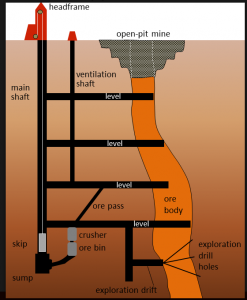9.4 Mining Techniques
The type of mining that is performed at a location is a function of technology, social license, and economics. It is in the best interest of the company extracting the resources to do so in a cost-effective way. [3] But profit for the company does not always align with what is best for the environment. Metal deposits are mined in a variety of different ways depending on their depth, shape, size, and grade. Relatively large deposits that are quite close to the surface and somewhat regular in shape are mined using open-pit mine methods, creating a giant hole in the ground, such as the one shown on the Bisbee Lavender Pit. This method is generally cheaper than making an underground mine, but it is also less precise, so it is necessary to mine a lot of waste rock along with the ore.
Underground mining is often used for higher-grade, more localized, or very concentrated resources.

Some ore minerals are mined underground by introducing chemical agents that dissolve the target mineral followed by extraction and subsequent
Whether mining occurs underground or from Earth’s surface is dictated by ore deposit depth, geometry, land-use policies, economics, the strength of the surrounding rock, and physical access to the ore to be mined. For example, deeper deposits might require the removal of too much material, or it may be too dangerous, too expensive, or impractical to remove. These factors may prevent materials from being mined from the surface, and cause a project to be mined underground.
Also, places, where the mining footprint cannot be large may force companies to pay for underground mining. The method of mining and mining is at all feasible depends on the price of the commodity and the cost of available technology to remove it and deliver it to market. Thus mines and the towns that support them come and go as the price of the commodity varies. Technological advances and market demands may reopen mines and revive ghost towns [3].
Mineral Processing
All ore minerals are mixed with less desirable components called gangue. Material found around ore which is less valuable and needs to be removed in order to obtain ore.
The process of physically separating gangue minerals from ore-bearing materials is called concentrating, which is a mechanical process.
Chemically separating a desired element from a host mineral that may contain many different elements using processes such as heating is called smelting (a process which chemically separates desired elements from ore minerals).
Finally, taking a metal such as copper and removing other trace metals such as gold or silver is done through the process of refining (removing trace elements from desired elements).
Typically, this is done one of three ways:
1. Materials can either be mechanically separated and processed based on the unique physical properties of the ore mineral. Example: separating gold from sand based on its high density and luster.
2. Materials can also be heated to chemically separated into their desired components, as witnessed when refining crude oil into gasoline
;or,
3. Materials can be smelted, in which controlled chemical reactions unbind metals from minerals they are bound within, such as when copper is taken out of chalcopyrite (CuFeS2).
Mining, smelting, and refining processes require enormous amounts of energy. Continual advances in metallurgy and mining practices aim to develop ever more energy-efficient and environmentally benign processes. [1]
As you can see from the video, you need large amounts of water to process the metal. Mining operations need to have plans in place to dispose of the water in more or less suitable conditions.
Exercises
To obtain copper for a car, you need to mine one or more copper-bearing minerals, for example, malachite, azurite, or bornite, among others. Each mineral has a different Copper concentration. Let’s find out how much copper could be extracted from bornite.
- Bornite has a chemical formula of Cu5FeS4. From the formula, we can see that it has 5 atoms of copper, 1 atom of iron, and 4 atoms of sulfur.
- If we multiply the number of atoms of the element by the atomic weight we can calculate the total weight of the element in the mineral.
|
Element |
Number of Atoms | Atomic Weight | Total Weight (AMU) |
| Cu | 5 | 64 | 320 |
| Fe | 1 | 56 | 56 |
| S | 4 | 32 | 128 |
| Molecular Weight | 504 | ||
- We can find the molecule weight by adding all the total weights, in this case, 504 AMU (atomic mass units)
- To find the fraction of copper in bornite, divide the total weight of copper in the mineral, 320, by the molecule weight, 504.
320/504 = 0.63; 0.63 *100 = 63% of copper per molecule of bornite.
Try doing this exercise with azurite Cu3(CO3)2(OH)2 and malachite Cu2(CO3)(OH)2. Which mineral has more copper?
Valuable material in the Earth, typically used for metallic mineral resources.
A variety of chemical weathering by which rock is stripped away at the molecular structure by water or solutions containing acid.
a solid, inorganic, and crystalline substance that has a predictable chemical composition and form by natural processes.
When the cloud droplets combine to form heavier cloud drops which can no longer "float" in the surrounding air, it can start to rain, snow, and hail... all forms of precipitation, the superhighway moving water from the sky to the Earth's surface.
Material found around ore which is less valuable and needs to be removed in order to obtain ore.

